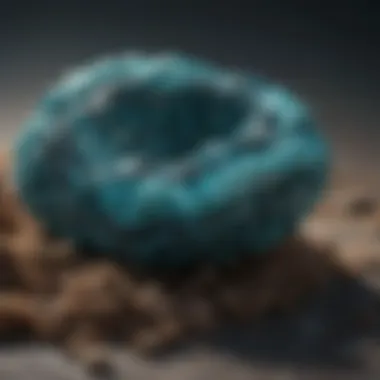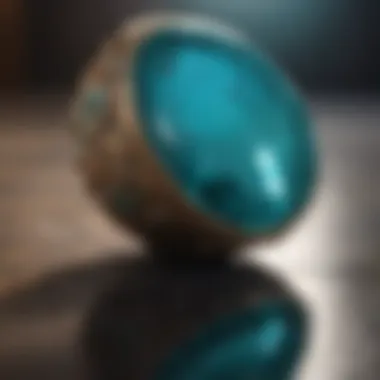Unlocking the Mysteries of Turquoise Stone Prices: A Comprehensive Guide


Overview of Turquoise Stones - A Dive into Pricing
The world of gemstones and minerals holds a certain mystique, captivating enthusiasts with their timeless allure. Turquoise stones, in particular, stand out for their unique beauty and cultural significance. From ancient civilizations to modern jewelry designers, turquoise has retained its charm and value over the ages. Understanding the factors that dictate turquoise stone prices is crucial for collectors, designers, and anyone fascinated by the world of gemstones. This article embarks on a journey through the intricate realm of turquoise stone pricing, shedding light on the diverse elements that impact their value. By exploring the origins, quality indicators, and market trends of turquoise stones, readers will gain invaluable insights into unraveling the mysteries of this mesmerizing gem.
Turquoise's Origins and Cultural Impact
Turquoise's history traces back thousands of years, with civilizations like the Ancient Egyptians, Persians, and Native Americans valuing this gemstone for its symbolic significance and healing properties. Its captivating blue-green hue evokes images of serene oceans and lush forests, infusing a sense of tranquility and balance. This gem has been used in adornments, amulets, and talismans, reflecting a deep-rooted cultural connection to spirituality and protection. Delving into turquoise's origins unveils a rich tapestry of beliefs and traditions, making it a gemstone steeped in folklore and reverence.
Evaluating Turquoise Stone Quality and Value
When assessing turquoise stones for their quality and value, several factors come into play. The intensity and evenness of color, the presence of matrix (veins running through the stone), and the degree of polish all contribute to determining the gem's worth. Turquoise from renowned mines such as the Sleeping Beauty Mine in Arizona commands higher prices due to its vibrant color and limited availability. Understanding these quality markers enables buyers to make informed decisions when purchasing turquoise jewelry or rough stones for custom designs. By learning how to appraise turquoise based on these criteria, collectors and enthusiasts can navigate the market with confidence and discernment.
Market Trends and Pricing Dynamics
The world of turquoise stone prices is not static; it fluctuates in response to market demand, availability of high-quality specimens, and emerging design trends. As more consumers recognize the allure of turquoise in contemporary jewelry, variations in prices and availability become noticeable. Factors such as artisan craftsmanship, ethical sourcing practices, and gemstone treatments also impact the pricing of turquoise jewelry. Staying informed about market trends and price dynamics empowers individuals to appreciate the intrinsic value of turquoise stones while making informed purchasing decisions.
Unveiling the Intricacies of Turquoise Stone Prices
Introduction to Turquoise Stones
Turquoise stones hold a captivating allure in the world of gemstones, known for their unique characteristics and historical significance. In this exploration of turquoise stone prices, understanding the essence of turquoise stones is paramount. These stones have fascinated civilizations across time, with their mesmerizing colors and patterns. The introduction sets the stage for delving deeper into the factors that dictate the value of turquoise stones.
Understanding the Appeal of Turquoise
Historical Significance
Unraveling the historical significance of turquoise unveils its journey through ancient cultures and civilizations. The stone's association with protection, wisdom, and spiritual healing has made it a coveted choice for jewelry and artifacts. Turquoise's presence in Egyptian, Persian, Native American, and Chinese cultures echoes its timeless appeal and enduring charm. The historical narrative of turquoise enhances its mystique and value in the realm of precious gemstones.
Symbolism in Various Cultures
Turquoise's symbolism varies across different cultures, reflecting diverse beliefs and traditions. From being a symbol of strength and status in ancient Egypt to signifying friendship and good fortune in Native American tribes, turquoise holds multifaceted meanings. Its symbolic associations with balance, harmony, and positive energy make it a cherished gemstone worldwide. The cultural symbolism of turquoise adds a layer of complexity and depth to its desirability and allure.
Unique Features of Turquoise


Color Variations
The spectrum of colors exhibited by turquoise stones, ranging from vivid blues to serene greens, offers a rich visual experience. These variations in color reflect the presence of distinct minerals like copper and iron in the stone, giving each piece its unique hue. The color diversity of turquoise allows for versatile jewelry designs and appeals to a wide range of preferences among gemstone enthusiasts.
Texture and Matrix Patterns
The textures and matrix patterns found in turquoise stones add character and individuality to each specimen. Spiderweb patterns, matrix veining, and smooth surfaces create a tactile allure that distinguishes turquoise from other gemstones. The fine details in texture showcase the natural formations within the stone, making each turquoise piece a work of art. Appreciating the intricate patterns and textures of turquoise enhances its desirability and aesthetic appeal.
Factors Impacting Turquoise Stone Prices
In the realm of turquoise stone trade, understanding the interplay of various factors is crucial for both sellers and buyers alike. The pricing of turquoise stones is influenced by a myriad of elements, such as their origin, authenticity, color, clarity, cut, and size. These aspects not only determine the value of the stones but also reflect their quality and rarity. By delving into the factors impacting turquoise stone prices, individuals can make informed decisions when purchasing or investing in these captivating gemstones.
Origin and Authenticity
When it comes to turquoise stones, their origin and authenticity play a pivotal role in determining their desirability and value. Native American Turquoise holds a special place in the hearts of collectors due to its rich cultural significance and traditional craftsmanship. On the other hand, Persian Turquoise is renowned for its deep and enchanting hues, showcasing the exquisite artistry of Middle Eastern lapidaries. Understanding the distinct characteristics of these origins can provide insight into the authenticity and uniqueness of turquoise stones, shaping their appeal in the market.
Native American Turquoise
Native American Turquoise signifies a heritage of craftsmanship and spiritual reverence. The distinctive matrix patterns and earthy tones of Native American Turquoise exude a natural charm that resonates with those appreciative of cultural heritage. Collectors often seek out pieces adorned with Native American Turquoise for their authenticity and aesthetic appeal, adding a touch of tradition to their gemstone collections. While the scarcity of genuine Native American Turquoise can drive up prices, its value lies not just in its monetary worth but in the cultural heritage it embodies.
Persian Turquoise
Persian Turquoise, with its mesmerizing sky-blue hues and fine, spiderweb matrix, exemplifies the allure of gemstones from the East. Prized for its intense colors and intricate patterns, Persian Turquoise stands as a testament to the skill and artistry of Iranian lapidaries. The rarity and exclusivity of Persian Turquoise make it a sought-after choice among connoisseurs seeking unique and sophisticated gemstones. Its enduring beauty and cultural significance contribute to its high value and appeal in the world of gemstone enthusiasts.
Color and Clarity
The color and clarity of turquoise stones are intrinsic factors that significantly influence their attractiveness and market worth. The distinction between intense blue and greenish turquoise reflects variations in mineral composition and light absorption, impacting the stone's perceived quality and value. Additionally, the presence of spiderweb patterns or solid color in turquoise can enhance its visual appeal and rarity, making certain specimens more prized than others.
Intense Blue vs Greenish Turquoise
Intense blue turquoise is valued for its deep, vivid color that evokes the vast skies and pristine waters, captivating the beholder with its luminous beauty. In contrast, greenish turquoise exhibits a softer hue reminiscent of lush landscapes and emerald forests, offering a more subtle yet enchanting aesthetic. The choice between intense blue and greenish turquoise ultimately comes down to personal preference, with each hue possessing its own unique charm and allure.
Spiderweb vs Solid Color
Turquoise stones featuring intricate spiderweb patterns command attention for their intricate designs and visual interest. The delicate network of lines crisscrossing the stone creates a mesmerizing effect that enhances its rarity and artistic appeal. On the other hand, solid-colored turquoise exudes a sense of purity and simplicity, showcasing the stone's natural beauty without distractions. Whether one favors the intricate beauty of spiderweb turquoise or the pure elegance of solid-colored specimens, both varieties have their own distinctive charm that appeals to gemstone enthusiasts.


Cut and Size
In the world of turquoise stones, the cut and size of a specimen can significantly impact its visual appeal and market value. Choosing between cabochons and faceted turquoise stones involves considerations of design, craftsmanship, and personal style. Likewise, the carat weight and dimensions of turquoise gems determine their rarity and desirability among collectors and jewelry designers, influencing their prices in the market.
Cabochons vs Faceted Turquoise
Cabochon-cut turquoise stones exhibit a smooth, rounded surface that accentuates the stone's natural texture and color variations, ideal for showcasing the gem's intrinsic qualities. In contrast, faceted turquoise stones are precision-cut to create geometric facets that enhance the stone's brilliance and light reflection, adding a touch of sophistication to jewelry designs. The choice between cabochons and faceted turquoise depends on the desired aesthetic and style preferences, offering versatility in creating unique and eye-catching pieces.
Carat Weight and Dimensions
The carat weight and dimensions of turquoise stones serve as essential factors in evaluating their rarity and market appeal. Larger turquoise gems with higher carat weights are often prized for their scarcity and impressive size, making them coveted by collectors seeking statement pieces. However, smaller turquoise stones with unique color patterns and clarity can also hold significant value, appealing to those looking for delicately crafted and wearable jewelry. Understanding the importance of carat weight and dimensions can help individuals assess the value and investment potential of turquoise stones, guiding them in making informed decisions when acquiring these precious treasures.
Market Trends and Pricing Strategies
Market Trends and Pricing Strategies play a pivotal role in understanding the pricing dynamics of turquoise stones. Turquoise, with its historical significance and symbolism, is subject to fluctuations based on market demands and pricing strategies implemented by sellers. Analyzing the Demand vs Supply Dynamics is crucial in determining the pricing trends. Factors like mining regulations significantly impact the availability of turquoise in the market. Mining regulations can either restrict or enhance the supply of turquoise, directly affecting its pricing. Fashion trends also influence the demand for turquoise, where popular designs or styles can drive up prices. Understanding the Pricing Determinants like Auction Prices vs Retail Values is essential. Auction prices may reflect the true market value of turquoise stones, while retail values can vary due to overhead costs. Certifications also play a vital role in determining the authenticity and quality of turquoise stones, influencing their pricing. Market trends and pricing strategies, along with demand vs supply dynamics, provide insights into the competitive landscape of turquoise stone pricing.
Demand vs Supply Dynamics
Impact of Mining Regulations
Discussing the Impact of Mining Regulations sheds light on how governmental policies and environmental factors affect turquoise availability. For instance, stringent regulations may limit turquoise extraction, resulting in a scarcity that drives prices higher. The unique feature of mining regulations lies in their ability to regulate sustainable mining practices, ensuring the long-term viability of turquoise sources. While regulations may pose challenges, they also promote ethical sourcing and preserve the quality of turquoise, benefiting the industry and consumers alike.
Influence of Fashion Trends
Exploring the Influence of Fashion Trends reveals how shifts in consumer preferences and design trends impact the demand for turquoise. When fashionable designers incorporate turquoise in their collections, it can create surges in demand and boost prices. The key characteristic of fashion trends is their ability to set new standards for what is considered desirable in the market. Utilizing fashionable elements can appeal to a broader audience and elevate the perceived value of turquoise stones. While fashion trends drive demand, they can also lead to rapid fluctuations in pricing, requiring adaptability in pricing strategies and market positioning.
Pricing Determinants
Auction Prices vs Retail Values
Comparing Auction Prices vs Retail Values offers insights into the different pricing structures within the turquoise market. Auction prices often reflect the competitive nature of bidding, providing transparency in value determination. On the other hand, retail values encompass additional costs like branding and marketing, influencing the final price. The key characteristic of auction prices lies in their ability to establish market trends and set benchmarks for pricing levels. Retail values, although higher due to added expenses, cater to a specific clientele seeking branded or curated turquoise products.
Role of Certifications
Discussing the Role of Certifications highlights the importance of third-party verification in the turquoise market. Certifications validate the authenticity and quality of turquoise stones, instilling confidence in buyers and potentially increasing prices. The unique feature of certifications is their ability to standardize grading criteria, streamlining comparisons between different turquoise offerings. While certifications enhance transparency, they can also add costs to the final price, impacting the overall affordability of turquoise. Understanding the significance of certifications is imperative for both buyers and sellers navigating the intricacies of turquoise stone pricing.


Investing in Turquoise Stones
Investing in Turquoise Stones holds considerable significance in the realm of gemstones. Turquoise has been esteemed for centuries for its unique beauty and cultural importance. When considering investing in Turquoise Stones, one must weigh various factors to make informed decisions. Turquoise's historical and symbolic value enhances its appeal as a collectible asset with the potential for long-term returns. The stability of Turquoise as a commodity in the market solidifies its position as a viable investment option. Understanding the nuances of Turquoise stone pricing is crucial for investors seeking to diversify their portfolios.
Long-term Value Considerations
Turquoise as a Collectible Asset
Turquoise as a collectible asset holds a distinctive allure in the gemstone market. Its scarcity, coupled with its captivating colors and patterns, makes it a sought-after piece for collectors. The rich history and cultural significance attached to Turquoise add a layer of value that transcends monetary considerations. Collectors are drawn to Turquoise not just for its aesthetic appeal but also for the stories and traditions it encapsulates. However, the limited supply of high-quality Turquoise specimens poses a challenge for collectors looking to acquire premium pieces.
Future Projections
Analyzing the future projections of Turquoise stones is essential for investors aiming for sustainable growth. As the demand for unique gemstones rises, Turquoise is poised to see a surge in its value over time. Factors such as dwindling Turquoise deposits and increasing appreciation for rare gemstones contribute to the positive outlook for Turquoise as an investment. Moreover, the evolving trends in jewelry and fashion forecast a continuous demand for Turquoise, paving the way for growth opportunities. Investors monitoring these trends and projections can position themselves strategically to capitalize on the anticipated rise in Turquoise stone prices.
Risk Management Strategies
Diversification in Turquoise Portfolio
Diversifying one's Turquoise portfolio is crucial for mitigating risks and maximizing return potential. By spreading investments across various types of Turquoise stones and origins, investors can safeguard their portfolio against market fluctuations and supply chain disruptions. Diversification also offers the opportunity to explore different facets of Turquoise, from color variations to texture patterns, reducing vulnerability to specific market vulnerabilities. However, diversification requires a deep understanding of Turquoise characteristics and market dynamics to make informed choices.
Emerging Market Opportunities
Exploring emerging market opportunities in the Turquoise industry presents a promising prospect for investors seeking growth. Emerging markets offer access to unique Turquoise specimens that may not be readily available in established markets. By staying abreast of emerging trends and market developments, investors can identify lucrative opportunities to expand their Turquoise portfolios. However, navigating emerging markets necessitates thorough research and a calculated approach to assess the potential risks and rewards effectively. Engaging with reputable dealers and staying informed about market trends are crucial steps in capitalizing on emerging market opportunities.
Conclusion
When delving into the realm of turquoise stone prices, arriving at a conclusion becomes paramount. This final section serves as the culmination of a comprehensive exploration, offering invaluable insights and key takeaways for gemstone enthusiasts, collectors, jewelry designers, and geology enthusiasts alike. Summarizing the intricate dynamics surrounding turquoise pricing, this conclusive portion emphasizes the significance of understanding the multitude of factors that influence the value of turquoise stones.
Summarizing Turquoise Price Dynamics
Key Takeaways
Embarking on a journey to grasp the essence of turquoise price dynamics unveils a myriad of key takeaways pivotal for enthusiasts. These key takeaways are not confined merely to the monetary value of turquoise stones but extend to the rich historical significance, quality determinants, and market trends that underpin their pricing. Understanding the rarity of certain origins, the impact of color intensity and clarity, and the role of industry certifications are vital components encapsulated in these key takeaways.
The focal characteristic of these key takeaways lies in their ability to unravel the intricate web of factors influencing turquoise prices. By comprehensively analyzing each element, enthusiasts can make informed decisions when acquiring turquoise stones, ensuring both authenticity and value. Despite the complexities involved, these key takeaways serve as beacons of guidance, illuminating the path towards acquiring exceptional turquoise specimens.
Future Outlook
Peering into the horizon of turquoise stone pricing presents a compelling outlook that resonates strongly with the evolving dynamics of the gemstone industry. The future outlook for turquoise prices hints at a blend of tradition and innovation, where established norms intertwine with emerging market trends. This notion not only pertains to the financial aspects but also encompasses the cultural and aesthetic appreciation for turquoise stones.
The distinctive feature of this future outlook lies in its adaptability to changing consumer preferences, technological advancements, and global market shifts. By embracing this evolution, enthusiasts can position themselves strategically in the turquoise market, foreseeing potential trends and leveraging opportunities for growth. While challenges may arise, the future outlook symbolizes resilience and dynamism, reflecting the enduring allure of turquoise stones in the world of precious gemstones.







